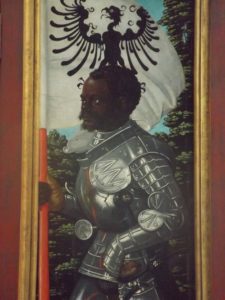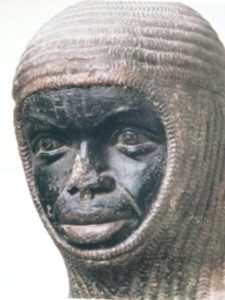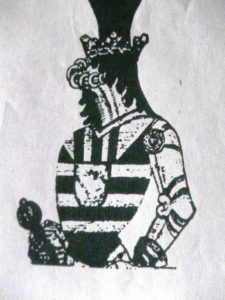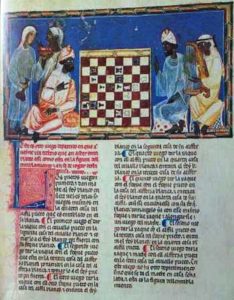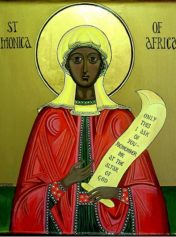BY RUNOKO RASHIDI*
The study of the African presence in history, whether in the African Diaspora or Africa itself, is a richly rewarding endeavor. In this study we realize that slavery alone is not African history and that African history is everybody’s history. The history of African people — Black people — is rich and comprehensive, inspiring and, often, little known. Nowhere is this more the case than the African presence in Medieval and Renaissance Europe.
The Moors: Light of Europe’s Dark Age
According to the Oxford English Dictionary, the Moors, as early as the Middle Ages and as late as the 17th century, were “commonly supposed to be black or very swarthy, and hence the word is often used for Negro.”
Early in the eighth century, after a grim and extended resistance to the Arab invasions of North Africa, the Moors joined the triumphant surge of Islam. Following this, they crossed over from Morocco over to the Iberian Peninsula where their swift victories and remarkable feats soon became the substance of legends.
In July 710, Tarif, with 400 foot soldiers and 100 horses, all Berbers, successfully carried out a mission in southern Iberia. Tarif, an important port city in southern Spain, is named after him.
It is clear, however, that the conquest of Spain was undertaken upon the initiative of Tarik ibn Ziyad. Tarik was in command of an army of at least 10,000 men.
In 711, the bold Tarik crossed the straits and disembarked near a rock promontory, which from that day since has borne his name — Djabal Tarik (“Tarik’s Mountain”), or Gibraltar. In August 711, Tarik won paramount victory over the opposing European army. On the eve of the battle, Tarik is alleged to have roused his troops with the following words:
“My brethren, the enemy is before you, the sea is behind; whither would ye fly? Follow your general; I am resolved either to lose my life or to trample on the prostrate king of the Romans.”
Wasting no time to relish his victory, Tarik pushed on with his dashing and seemingly tireless Moorish cavalry to the Spanish city of Toledo. Within a month’s time, General Tarik ibn Ziyad had effectively terminated European dominance of the Iberian Peninsula.
In the aftermath of these brilliant struggles, thousands of Moors flooded into the Iberian Peninsula. So eager were they to come that some are said to have floated over on tree-trunks. Tarik himself, at the conclusion of his illustrious military career, retired to the distant East, we are informed, to spread the teachings of Islam.
There is really no need to speculate on the ethnicity of these early invaders of the conquest period. Primary Christian sources relating to the conquest, particularly the Primera Cronica General of Alfonso X, make the following observation regarding the Moors: “Their faces were black as pitch, the handsomest amongst them was as black as a cooking pot.”
The Black Saint Maurice: Knight of the Holy Lance
Of all the many Black men in the history of Europe, few have excited the imagination more than Saint Maurice. He was a Black saint in an area then and now that has very few Black inhabitants. He was also a Black knight. Indeed, we could call him a knight in shining armor. He is no less than remarkable.
The name Maurice is derived from Latin and means “like a Moor.” The Black Saint Maurice (the Knight of the Holy Lance) is regarded as the great patron saint of the Holy Roman Germanic Empire. He is also known, especially in Germany, as Saint Mauritius. The earliest version of the Maurice story and the account upon which all later versions are based, is found in the writings of Bishop Euchenus of Lyons, who lived more than 1500 years ago. According to Eucherius, Saint Maurice was a high official in the Thebaid region of Southern Egypt — a very early center of Christianity.
Specifically, Maurice was the commander of a Roman legion of Christian soldiers stationed in Africa. By the decree of Roman emperor Maximian, his contingent of 6,600 men was dispatched to Gaul and ordered to suppress a Christian uprising there. Maurice disobeyed the order. Subsequently, he and almost all of his troops were martyred when they chose to die rather than persecute Christians, renounce their faith and sacrifice to the gods of the Romans. The execution of the Theban Legion occurred in Switzerland near Aganaum (which later became Saint Maurice-en-Valais) on Sept. 22, either in the year 280 or 300.
In the second half of the fourth century, the worship of St. Maurice spread over a broad area in Switzerland, northern Italy, Burgundy, and along the Rhine. The major cities of Tours, Angers, Lyons, Chalon-sur-Saone, and Dijon had churches dedicated to St. Maurice.
By the epoch of Islamic Spain, the stature of St. Maurice had reached immense proportions. Charlemagne, the grandson of Charles Martel and the most distinguished representative of the Carolingian dynasty, attributed to St. Maurice the virtues of the perfect Christian warrior. In token of victory, Charlemagne had the Lance of St. Maurice (a replica of the holy lance reputed to have pierced the side of Christ) carried before the Frankish army. Like the general populace, which strongly relied on St. Maurice for intercession, the Carolingian dynasty prayed to this military saint for the strength to resist and overcome attacks by enemy forces.
In 962, Otto I chose Maurice as the title patron of the archbishopric of Magdeburg, Germany. By 1000 C.E. the worship of Maurice was only rivaled by St. George and St. Michael. After the second half of the 12th century, the emperors were appointed by the pope in front of the altar of St. Maurice, in St. Peter’s Cathedral in Rome.
In Halle, Germany, a monastery with a school attached to it was founded and dedicated to St. Maurice in 1184. In 1240, a splendid Africoid statue of St. Maurice was placed in the majestic cathedral of Magdeburg — the first Gothic cathedral built on German soil. I was actually able to visit this cathedral and photograph the statue in 2010. The facial characteristics of the statue are described by historian Gude Suckale-Redlefsen in his classic work, The Black Saint Maurice, as follows:
“The relatively small opening in the closely fitting mail coif was sufficient for the Magdeburg sculptor to produce a convincing characterization of St. Maurice as an African. The facial proportions show typical alterations in comparison with European physiognomy. The broad, rounded contours of the nose are recognizable although the tip has been broken off.
“The African features are emphasized by the surviving remains of the old polychrome. The skin is colored bluish black, the lips are red, and the dark pupils stand out clearly against the white of the eyeballs. The golden chain mail of the coif serves, in turn, to form a sharp contrast with the dark face.”
A center of extreme devotion to St. Maurice was developed in the Baltic states, where merchants in Tallin and Riga adopted his iconography. The House of the Black Heads of Riga, for instance, possessed a polychromed wooden statuette of St. Maurice. Their seal bore the distinct image of a Moor’s head.
In 1479, Ernest built several castles, one of which he named after St. Maurice — the Moritzburg. Under a banner emblazoned with the image of a Black St. Maurice, the political and religious leaders of the Holy Roman Empire battled the Slavs. The cult of St. Maurice reached its most lavish heights under Cardinal Albert of Brandenburg (1490-1545), who established a pilgrimage at Halle in honor of the Black saint.
From the early 16th century, and now in the Metropolitan Museum of Art, hangs a magnificent painting by Lucas Granach, the elder of St. Maurice, resplendent as a knight in shining armor. In the Alta Pinakothek in Munich hangs the painting by Matthias Grunewald of St. Maurice and St. Erasmus in heaven. Grunewald was the greatest painter of the German Renaissance. And in the Gemaldegalerie in Berlin is the painting by Hans Baldung Grien of St. Maurice under the banner flag of the German imperial eagle on one side, a painting of the adoration of the magi (with a Black king, the youngest of the three magi), in the center, and St. George and the dragon on the opposite side. I have seen and photographed all four of these magnificent art objects.
Between 1523 and 1540, people from throughout the empire journeyed to Halle to worship the relics of St. Maurice. The existence of nearly 300 major images of the Black St. Maurice have been catalogued, and even today the veneration of St. Maurice remains alive in numerous cathedrals in eastern Germany.
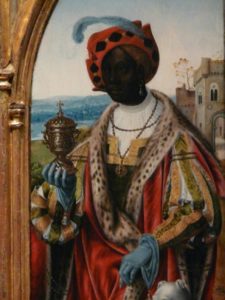
One of the most fascinating aspects of the African presence in Europe is the wide collection of images of the Black Magus/King in European art. Although sometimes identified as a Moor, he is not a Muslim. Such paintings adorn the galleries and museums throughout Europe and the United States. These are wonderful images of the wise and distinguished African king who followed a star and came to pay homage and provide rich treasures to the Christ child in the time of Herod in the manger in Bethlehem as described in the Gospel of Matthew.
The appearance of the Black king in European art appears at least by the 14th century and probably earlier. The Moors were a fixture in Europe at this time. By the 15th and 16th centuries, thousands of paintings depicting the Adoration of the Black Magus or King had been made.
The Black magus is the youngest of the three kings and traditionally he is said to come from Ethiopia. He is sometimes called a Moor and he is, interestingly enough, the king who stands farthest away from the Christ child. His name is Balthazar and his present to the Christ child is the gift of myrrh.
Sometimes, particularly in the Dutch world, another of the kings is identified as Black. This is Gaspar, identified as a king from Asia and he is also credited sometimes as bringing myrrh, and sometimes frankincense.
Sir Morien: Black Knight of King Arthur’s Round Table
Few documents portray the ethnicity of the Moors in medieval Europe with more passion, boldness and clarity than Morien. Morien is a metrical romance rendered into English prose from the medieval Dutch version of the Lancelot.
Morien is the adventure of a splendidly heroic Moorish knight (possibly a Christian convert), supposed to have lived during the days of King Arthur and the Knights of the Round Table. Morien is described as follows:
“He was all black, even as I tell ye: his head, his body, and his hands were all black, saving only his teeth. His shield and his armour were even those of a Moor, and black as a raven.”
Initially in the adventure, Morien is simply called “the Moor.” He first challenges, then battles, and finally wins the unqualified respect admiration of Sir Lancelot. In addition, Morien is extremely forthright and articulate. Sir Gawain, whose life was saved on the battlefield by Sir Morien, is stated to have “harkened, and smiled at the black knight’s speech.” It is noted that Morien was as “black as pitch; that was the fashion of his land — Moors are black as burnt brands. But in all that men would praise in a knight was he fair, after his kind. Though he were black, what was he the worse?” And again: “his teeth were white as chalk, otherwise was he altogether black.”
“Morien, who was black of face and limb” was a great warrior, and it is said that: “His blows were so mighty; did a spear fly towards him, to harm him, it troubled him no whit, but he smote it in twain as if it were a reed; naught might endure before him. Ultimately, and ironically, Morien came to personify all of the finest virtues of the knights of medieval Europe.
“It should be noted that for a very long period the Dutch language used Moor and Moriaan for Black Africans.”
Among the Lorma community in modern Liberia, the name Moryan is still prominent.
The Expulsion From Spain and the Dispersal of the Moors
In Iberia, Christian pressures on the Moors grew irresistible. Finally, in 1492, Granada, the last important Muslim stronghold in al-Andalus, was taken by the soldiers of King Ferdinand and Queen Isabella, and the Moors were expelled from Spain. In 1496, to appease Isabella, King Manuel of Portugal announced a royal decree banishing the Moors from that portion of the peninsula. The Spanish king Philip III expelled the remaining Moors by a special decree issued in 1609. Fully 3,500,000 Moors, or Moriscos, as their descendants were called, left Spain between 1492 and 1610.
An estimated million Moors settled in France. Others moved into Holland. A very curious story in the Netherlands is that of Zwarte Piet (Black Peter). By some accounts Zwarte Piet, the companion to Sinterklaas (Santa Claus), was a Moorish orphan boy whom Sinterklaas adopted and trained as his assistant.
By 1507, there were numerous Moors at the court of King James IV of Scotland. One of them was called Helenor in the Court Accounts, possibly Ellen More. There were at least two other Black women of the royal court who held positions of some status, and they are stated as having had maidservants dress them in expensive gowns.
In 1596, Queen Elizabeth, highly distressed at the growing Moorish presence in England, wrote to the lord mayors of the major cities that:
“There are of late divers blakamores brought into this realm, of which kinde of people there are already too manie.”
*Runoko Rashidi is based in Los Angeles and Paris. He is the author of “Black Star: The African Presence in Early Europe.” In August 2014, he is leading a tour group through several cities in Western Europe focusing on the African heritage, especially in the museum collections. For more information and to join the tour write to: Runoko@yahoo.com or go to www.travelwithrunoko.com


